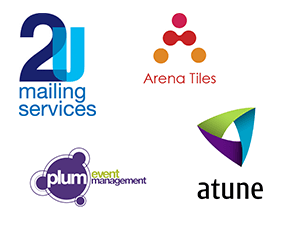 Here’s why simple logo design is best for your branding identity:
Here’s why simple logo design is best for your branding identity:
Your business logo needs to scale and reproduce easily.
If your business logo design is fussy or over stylised you could lose some of the detail when translating it for different purposes.
So whether you choose to use a logotype (your business name in stylised letters), an icon or both for your logo, every little bit of detail needs to work across a huge range of sizes and mediums.
A simple scale test is to shrink your logo down to postage stamp size: can you still read the words in the logotype?
In order of importance, the four main graphic elements of your branding identity are:
- Logo icon
- Logotype/words (could be your business name and/or slogan)
- Marks or other imagery
- Colour palette
Your designer can help you choose which elements work best in each application. You may want to use only one or two parts of your brand identity for some applications which don’t demand the full deal.
For example, you might want just the logo on a hat, a printed icon and logotype on an umbrella, or some of your branding marks or other imagery used as motifs across wrapping or packaging.
If you plan to reproduce your business logo in different mediums, check the cost difference between a single colour/clear version and a full colour version.
Complex multi-coloured designs, including tints or highlights, are simple enough to reproduce with modern printers on paper, stickers and the like, but can present challenges for mediums such as embroidered cloth or metal.
Depending on the materials you use to reproduce the logo, you might not have the full range of colour options, which is why you need a strong single colour version of at least the main logo icon. Think of it as your modern-day version of the cattle herder’s branding iron. The less intricate the detail, the easier it will be for different types of machines to reproduce through sewing, glass etching or metal embossing.
In recent years there has been a move towards simpler, cleaner, less complex branding and logo design. Really smart companies pick a logo design that can be developed fairly easily without losing any of the brand equity or losing sight of who they are.
Expert Tip: “Our standard philosophy when we’re working with a client’s brand is to immediately think of common applications. They’ll definitely want signage and marketing material, they’ll need email signatures and website designs, and they’ll probably want uniforms or other branded clothing. It’s important the branding has some flexibility and doesn’t just look good when it’s massive on a piece of A4. It needs to work when it’s shrunk down on a business card, or when you enlarge it for signage on a building.”
Richard Baker, Creative Director, Kwik Kopy Australia.






